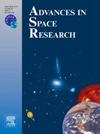Developments of empirical models for vertical adjustment of precipitable water vapor measured by GNSS
IF 2.8
3区 地球科学
Q2 ASTRONOMY & ASTROPHYSICS
引用次数: 0
Abstract
In some applications of Precipitable Water Vapor (PWV) measured by Global Navigation Satellite System (GNSS), we have to consider PWV vertical adjustments (PWVVAs) due to the height differences between the target sites and the GNSS sites. Thus, developments of global empirical models for PWVVAs deserve our attention. In this study, we found that the decrease factor of water vapor (λ) can be also used as the decrease factor of PWV when we use the Smith’s vertical variations of water vapor. Based on this conclusion, PWVVAs can be carried out by using the empirical values of λ and atmospheric total pressure (or zenith hydrostatic delay). Thus, we gave two empirical models for PWVVAs (i.e. PWVVA-Ⅰ and PWVVA-Ⅱ). On the other hand, another aim of this research is to develop an empirical model of PWVVA using neural network (i.e. PWVVANN). Measured PWV of one site, the heights of this site and the target site, and empirical values of λ and zenith hydrostatic delay were considered as the input parameters of the PWVVANN model. The output is the PWV at the target height. Global statistical results verify that the PWVVANN model has a accuracy of 1.08 mm and its accuracy has increased by respective 30.7 %, 24.4 % and 23.6 % when compared with PWVVA-Ⅰ, PWVVA-Ⅱ and a state of the art model (i.e. the GPWV-H model).
开发全球导航卫星系统测量的可降水水汽垂直调整经验模型
在全球导航卫星系统(GNSS)测量可降水水汽(PWV)的某些应用中,我们必须考虑由于目标站点和 GNSS 站点之间的高度差异造成的可降水水汽垂直调整(PWVVAs)。因此,针对 PWVVA 的全球经验模型的开发值得我们关注。在这项研究中,我们发现,当我们使用史密斯水汽垂直变化时,水汽下降因子()也可以用作脉宽调制的下降因子。根据这一结论,可以利用和大气总压(或天顶静水延迟)的经验值来进行 PWVVA。因此,我们给出了 PWVVA 的两个经验模型(即 PWVVA-Ⅰ 和 PWVVA-Ⅱ)。另一方面,本研究的另一个目的是利用神经网络建立 PWVVA 的经验模型(即 PWVVANN)。PWVVANN 模型的输入参数包括一个站点的实测 PWV、该站点和目标站点的高度以及天顶静水延迟的经验值。输出为目标高度的 PWV。全局统计结果证实,PWVVANN 模型的精度为 1.08 毫米,与 PWVVA-Ⅰ、PWVVA-Ⅱ 和最先进的模型(即 GPWV-H 模型)相比,精度分别提高了 30.7%、24.4% 和 23.6%。
本文章由计算机程序翻译,如有差异,请以英文原文为准。
求助全文
约1分钟内获得全文
求助全文
来源期刊

Advances in Space Research
地学天文-地球科学综合
CiteScore
5.20
自引率
11.50%
发文量
800
审稿时长
5.8 months
期刊介绍:
The COSPAR publication Advances in Space Research (ASR) is an open journal covering all areas of space research including: space studies of the Earth''s surface, meteorology, climate, the Earth-Moon system, planets and small bodies of the solar system, upper atmospheres, ionospheres and magnetospheres of the Earth and planets including reference atmospheres, space plasmas in the solar system, astrophysics from space, materials sciences in space, fundamental physics in space, space debris, space weather, Earth observations of space phenomena, etc.
NB: Please note that manuscripts related to life sciences as related to space are no more accepted for submission to Advances in Space Research. Such manuscripts should now be submitted to the new COSPAR Journal Life Sciences in Space Research (LSSR).
All submissions are reviewed by two scientists in the field. COSPAR is an interdisciplinary scientific organization concerned with the progress of space research on an international scale. Operating under the rules of ICSU, COSPAR ignores political considerations and considers all questions solely from the scientific viewpoint.
 求助内容:
求助内容: 应助结果提醒方式:
应助结果提醒方式:


